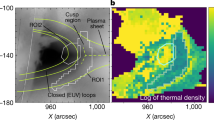Abstract
THE arguments which have been brought forward to explain the origin of the spectra of nebulæ may be used with certain modifications to explain the spectrum of the solar corona; for it must be composed of such atoms thrown out by radiation pressure or other agencies from the general atmosphere of the sun. On account of the lower temperature of the sun, the atoms concerned should be non-ionised, or such as can be easily ionised. They should also be light. All these considerations narrow down the choice to a very few elements like Li+, Be+, B+, C, N, O … Si, P, S, P+, and S+, etc. It is the object of this note to discuss how these elements can give rise to the coronal spectrum.
This is a preview of subscription content, access via your institution
Access options
Subscribe to this journal
Receive 51 print issues and online access
$199.00 per year
only $3.90 per issue
Buy this article
- Purchase on Springer Link
- Instant access to full article PDF
Prices may be subject to local taxes which are calculated during checkout
Similar content being viewed by others
Rights and permissions
About this article
Cite this article
SAHA, M. The Origin of the Spectrum of the Solar Corona. Nature 121, 671–672 (1928). https://doi.org/10.1038/121671a0
Issue Date:
DOI: https://doi.org/10.1038/121671a0
Comments
By submitting a comment you agree to abide by our Terms and Community Guidelines. If you find something abusive or that does not comply with our terms or guidelines please flag it as inappropriate.



